| Discovering My First Asteroid |
| "Don't count your asteroids till they are numbered" - Roy A. Tucker |
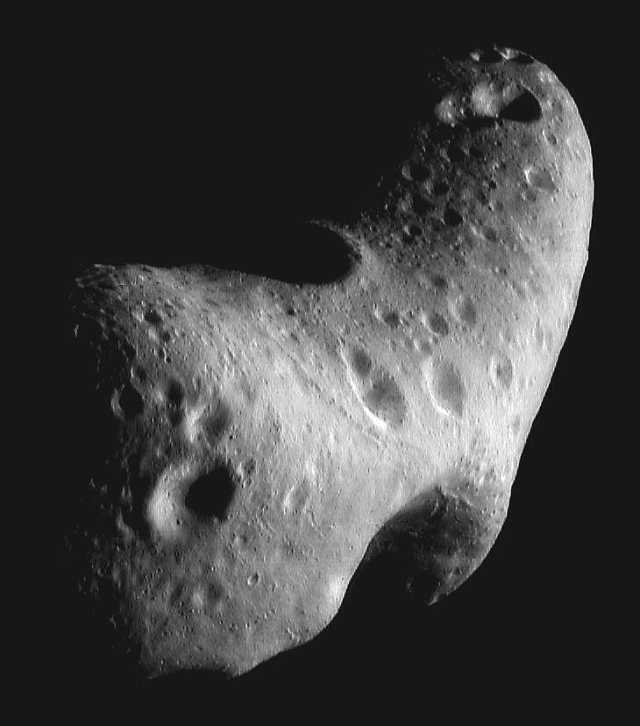 |
| Near-Earth Asteroid 433 Eros as imaged by NEAR Spacecraft. (Credit: NASA) |
| Early Years: As an amateur astronomer, I was never really interested in asteroids. Except for the bright Vesta or Ceres, I have observed just a handful of asteroids visually through my 20X60 binoculars. Asteroids fascinated me for an entirely different reason. Being a trained artist, I liked to paint asteroids that were imaged by spacecraft. Starting with Galileo�s flyby of Asteroid Ida, each time a spacecraft would image an asteroid, I would paint it based on close-up images. A few years after I moved to New Delhi, I heard from the educator at the Nehru Planetarium that a 17 or 18-magnitude asteroid would be coming to a good Opposition and a would be a good target for photometry as suggested by Prof. Tom Gehrels of University of Arizona. Though I was not interested in observing these asteroids, I came in touch with Prof. Gehrels, which is a very important event of my life. In September 1999, Prof. Gehrels visited New Delhi and gave a talk at the Nehru Planetarium about the Universe. I attended the lecture as a journalist to report about it for my newspaper. After the lecture, I had a chance to personally interact with Prof. Gehrels who gave me a crash course on Near-earth asteroids and the threats they pose. Having got my story, I got a chance to drop Prof. Gehrels at his hotel in a cab. During the course of our talk, I casually asked him about the kind of asteroid research being done in India. He said that there were no asteroid surveys in India although she has large astronomical observatories. Realising a possible chance for amateur contribution in this area, I quickly proposed to him, "What if I start an observatory here and do follow-up observations of NEOs." He thought for a while and said, "That would be a great thing for India. You will be great man if you could do that." Elated by his response, I quickly thought of what all needs to be done... telescope... CCD... dark skies... After we reached his hotel, he got out of the cab and said, "A lot of people have told me this, no one has so far done anything about it." Starting Out : Fired by his conclusion, I set out to study asteroids. In the next 12 months, I virtually read everything I could get hold of on asteroids. My office has really been of help in providing free Internet, which further helped me in this extensive study. I joined mailing lists on asteroids, visited observatories and photocopied all books on asteroids. In all, I made over 6,000 pages of notes. |
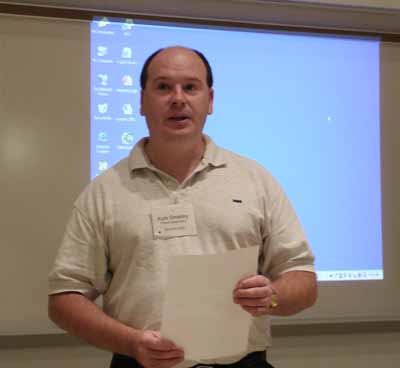 |
| Kyle E. Smalley, at Minor Planet Amateur-Professional Workshop 2002. Kyle now works at the Minor Planet Center. (Credit: Jay Tate) |
| Meanwhile, I made friends with Kyle Smalley, a retired nuclear reactor engineer who worked on US submarines. Kyle was interested in asteroids and had started observing asteroids with his club's 30-inch telescope from Powell Observatory, near Kansas City, USA. Kyle started observing asteroids 6 months ago and had tonnes of patience answering my stupid questions. He helped me download a free astrometry software called Charon and sent me 3 CCD images of an asteroid which he had observed so that I could practice as I neither had CCD nor a good telescope. |
| From the start, Charon was not easy to learn. The software was DOS-based and it took me good three months to make the whole thing work. After practically learning how to do astrometry, I was up against anything to set up an observatory here in India and start observing.
I had a 16-inch blank which could be made into a telescope and after doing some rough estimate I realised that I would need at least Rs 2 lakhs to set up an observatory with a CCD camera. But with such kind of money the observatory would take two years or more to complete. I decided to raise some funds with the help of "rich" relatives and friends. But I failed to convince the importance of asteroid research. I visited a close by professional observatory and spoke to the director about my project. He was convinced that I was serious about it and told me that I could use a 15-inch f/15 Cassegrain with an Sbig ST-7 CCD camera provided I get someone to guide me. But the observatory was more than a day's journey from New Delhi and asteroid observing needs at least 2 nights in a row and every week, something that was not possible with my current job. I decided to take 3 months off during that winter and observe continuously. I returned to Delhi and made detailed plans for the 3 months to come in winter. It Happened One Night: One night after finishing my work I was chatting with a friend, Gregg Paris, in California. Gregg is a "veteran amateur astronomer" and a retired USAF pilot who served onboard the USS Kitty Hawk during the Korean War. Gregg and I are good friends though we have never met. He told that a local telescope store had put up Meade LX200 12-inch telescopes on sale and that it would be ideal for asteroid hunting. I counted the money in my pocket and told him I had Rs 100 or $2 with me and there was no way I could dream of affording a $3,000 telescope, besides it was 1 in the morning even if I wanted to ask someone. Gregg quickly asked me if I could come up with the money later. I said I don't have anyone but I can try for sure. He took out his Credit Card and ordered the telescope right away. I was shocked at first. Here was a guy who spent $3,000 on a telescope without even seeing my face! Lesson No.1: If you are sincere enough, things will fall into place. Anyway, I finally managed to raise the $3,000 for the telescope with the help of Mr T.M. Kumar of New Delhi. The telescope took good 6 months to get through shipping and customs and finally arrived in March 2002. After paying the import duty, I had little money to buy a CCD camera. In the meanwhile, I spent a lot of money and applied for the Planetary Society's Shoemaker Grant in order to buy a CCD camera. But the proposal didn't make it and I was left without a camera. In the meanwhile, with the help of a friend, I completed a roll-off-roof observatory. But due to weird Municipal building laws in Delhi, I was unable to put it. At one point, the police landed up after a mad neighbour complained! With out a CCD camera and an observatory, my dream of discovering an asteroid seemed difficultome in winter. |
 |
| Gregg Paris with my 12-inch LX200 F/10 Schmidt-Cassegrain. |
| Ten Days In Tucson
: There were a few workshops in the US during the summer of 2002 and I was very keen in attending them. After realising that I must do something without a CCD rather than waiting for it to happen, I took a risk and went to the US for the workshops. My Yahoo! friends helped a lot. Though I had never seen them or met them, they arranged for my stay and food. I stayed with Darrel Dullack, an amateur astronomer, in Michigan, and observed with him during free time. I also planned to visit well-known asteroid-hunter Roy A. Tucker of Arizona, whom I knew again through Yahoo! Roy, a professional CCD instrumentation engineer, holds a world record for maximum number of near-earth asteroid discoveries by an amateur astronomer. Besides, he has also discovered a comet and over 300 main-belt asteroids. With $200 in pocket, I took a 3-day bus journey from Michigan to Arizona in the last week of June. The bus went through 7 states arriving in Tucson 10 hours late! But thankfully, Roy was there waiting for me at the bus station. Tucson is an astronomer's paradise with over 300 clear nights a year and minimum light pollution. A desert city, Tucson clime reminded me of India and I felt at home. |
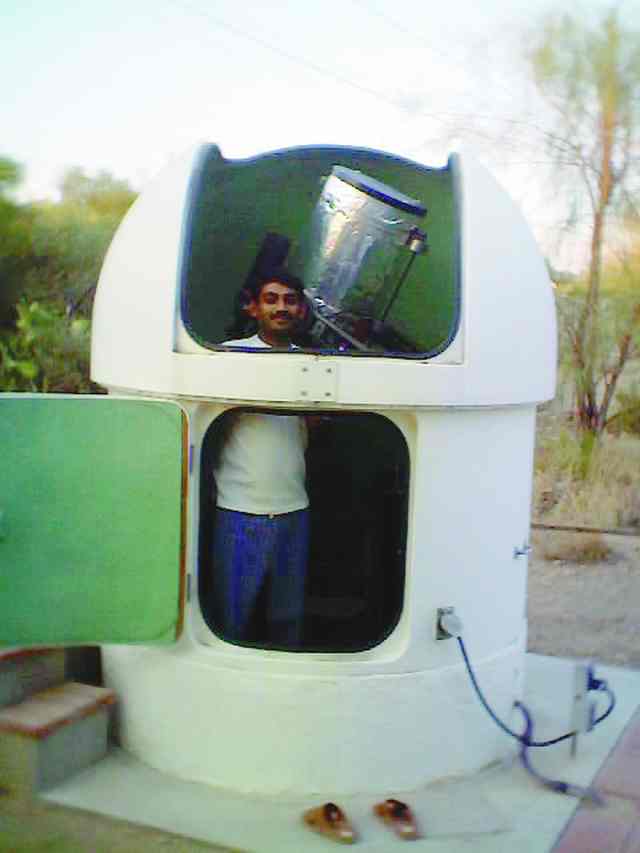 |
| Roy's C14 Telescope. He discovered three NEAs and a Comet with this instrument and home-built CCD camera. (Credit: Roy A. Tucker) |
| After hazy skies, during the first few days, I finally got a chance to observe under good skies on the June 28.
The instrument I was using is called MOTESS � Moving Object Transient Event Search System. On any given night, the three 14-inch F/5 telescopes collect 150 triplets-3 images of the same field. After the images are collected in the night, each image is processed and then the triplets are blinked to detect asteroids. As my luck would have it, the Opposition region was right in the Milkyway where the asteroids are brightest. Besides, summer time is considered the worst time to discover asteroids. |
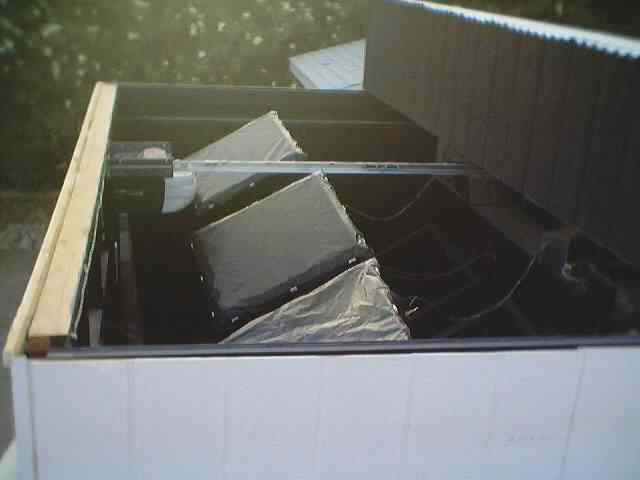 |
| Three telescopes of the MOTESS system wait for sunset in Roy's backyard in Tucson. |
| Unlike normal images that have comparatively less stars, Milkyway fields are full of stars and asteroids are difficult to detect among these thousands of stars.
Here is what happens on a typical night. The MOTESS system is an automatic image-collector. Just switch it on in the evening and the scopes collect the images automatically till 6 am. Then you take dark frames and shut down the scopes before sunrise. Since the images are taken in scan-mode, a second computer cuts these scans and arranges them into triplets, i.e. same image from each telescope is taken at 15-minute interval are made into triplets for blinking. Then another programme puts the correct RA information into the fits header for all the 150 triplets, after which we process the images for dark and flat field using Maxim DL. Next process is to plate solve the images during which a star catalogue is used for adding RA and DEC information of each star in every image so that we can get the position of the asteroid in comparison to the stars. This takes about 3 hours, and by 12 in the afternoon the images are ready for blinking. Using a software called PinPoint we take the 3 images of a triplet and blink, then look for objects that move and do astrometry for them. A single triplet takes about 10 minutes to blink so you can get the picture about blinking 150 triplets. I start at around 12 noon, finish the whole lot buy 4 am the next morning. Easy said than done...The first day I was in Tucson, Roy gave me some images which he had taken 2 years ago with his C14 telescope and asked me to look for asteroids. Boy! I found tonnes of them, all cosmic ray fakes! But that was a great lesson. Since the skies were bad, I worked a lot on these images and learned how to find and identify asteroids. Most of the asteroids in these images were really bright, about 18 magnitude. |
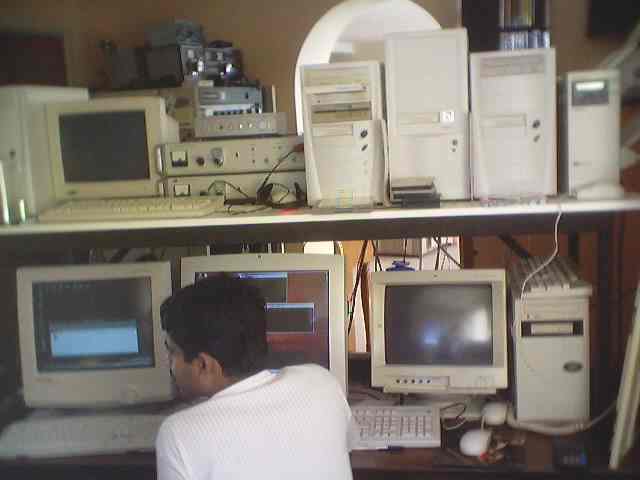 |
| MOTESS Control Center (Credit: Roy A. Tucker) |
| The skies cleared a bit on June 28 and we got some good images in the early part of the evening. I got about 28 good triplets, found 5 objects and then waited for the second night. 29th was clear relatively and I got 2 nights on 3 of those 5 objects. Most of them were bright 17-18 magnitude so I knew for sure that they were known ones and I checked with the MPchecker on the Minor Planet Centre website and found that there was one 18.7 magnitude fellow with no earlier discovery credit. But for some reason, the second night astrometry was noisy and I didn�t get a credit. Bad luck!
30th too was terribly cloudy so I went up to Kitt Peak with Roy and had a great time there looking at all the big telescopes we read in Sky and Telescope. Jeff Larson at Spacewatch was really nice to us and he knew about me from Prof. Tom Gehrels. In fact, Jeff offered me and Roy to stay back for the night and watch Spacewatch in action. After coming back from Kitt Peak, we went and met Prof. Tom Geherls at the University of Arizona. He was happy to see that I had come all the way in search of asteroids. |
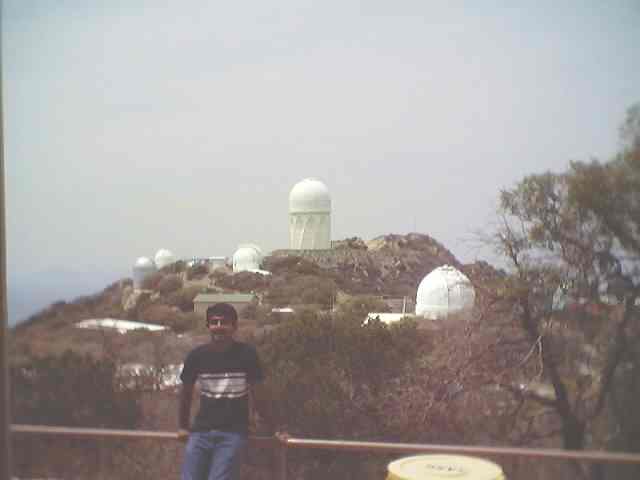 |
| At Kitt Peak National Observatory, west of Tucson, Arizona. (Credit: Roy A. Tucker) |
| After lunch, I gave Prof. Geherls some books that I had got from India and we went to University bookstore, as Prof. Geherls wanted to present me something. I always liked the Asteroids 2 book he wrote, which is now out of print. I asked for it to which he said that he had a personal copy, which he signed for me. Skies were bad that night so we just saw a few old images and hit the hay.
A few days later, on July 3, the sky cleared up and I got to see what Arizona skies were � deep blue skies with the brown desert below, really a great site. As the night fell, we started MOTESS and relaxed under the stars. I went off to sleep outside while Roy shut the cameras at 4 am. Then he told me that he would get the images processed and keep them ready by 11 am so that I could take a look. But the next day was July 4, US Independence Day. An astronomer from the GNAT project came in the morning, so Roy couldn't process the images. I waited till 3 pm for the images to be plate-solved and dozed off while reading Clyde Tombaugh's (the discoverer of Pluto) autobiography by David Levy. Long Nights: Roy woke me up at 4 pm and told me that the images were ready. Starting from the early morning images, I started blinking from triplet number 150... 149... 148... the last batch of images had a lot of twilight so I didn�t spend too much time, but it had a few bright asteroids so I did astrometry on them anyway. At 5.30 pm, Roy's friends came over for dinner. After a small talk, I got back to blinking. I wanted to finish 50 triplets before the dinner time but Roy asked me to join early so I stopped at 120, had a quick dinner and got back while they were watching Koyaanisquatsi (a great film) on video. Since the Milkyway was more towards the midnight fields, the morning images were relatively easier with just a few hundred stars. At 7.30 pm Roy came to say hello and see how I was doing with the images. Just then I was getting into the Milkyway images so I said not too bad and I turned to the screen. Between the dark lanes, I found a faint but distinctly moving object. I knew it was an asteroid but I was in two minds over its status. I told Roy, "Oh not too bad, I have one here, did astrometry for the object and went on to more fields. A bit later, I found another object that was rather diffuse but moving N-S at an angle. Bang astrometry and went on. By the time I finished the Milkyway images, it was 2 am and I was exhausted, but I still had 30 triplets to go and wanted to finish them before dawn. Sanath (the educator at Nehru Planetarium, New Delhi) gave me a brief company during those blinks through Yahoo! IM. By 4.30 am, I was too tired and stopped on the 12th triplet because those Milkyway images had made me feel sea sick with constant churning of stars across the field. After shutting down the MOTESS, I went to bed and woke up at 11 am. Roy, in the meanwhile, sent my astrometry measurements to Gareth Williams at Minor Planet Center, Harvard-Smithsonian Centre for Astrophysics, USA, and got a reply giving the details of the object identification. Of the 30 objects I found, there were 4 with no designations. So they might have been new ones. So I immediately started looking for those objects in last night's images. (To claim a discovery you need at least 2 nights of observations on a single object with 3 observations per night, actually it is more complex!) The first two VR0017 and VR0018 were fakes, just some cosmic ray hits that I thought were asteroids! They were not there on the second night's images. Then I looked at VR0024, it was the one in the dark lane of the Milkyway so it was clearly there in the first night but I couldn�t locate in the second night. Disappointed, I went to VR0028. Bang! There it was, the diffuse fellow. Three clicks and I had the astrometry. "Cool", I thought but just to make sure that I had another object as backup, I went back to VR0024 image and looked at it again for the second night's position. I found an object moving close to a group of 3 stars but I was not sure. I tried to do astrometry but Pin Point just managed to get one position because the object was close to a lot of stars and the software was unable to get a centroid. Unable to do much but not wanting to lose the object, I called Roy to take a look again. He said that the objects look the same and that we can try to get astrometry done on another software called Astrometrica, which has better control over the object centroid. After painful attempts, we gave up because the fields were rotated in Pinpoint and Astrometrica and there was no way we could get the astrometry for the second night. I suggested that we can wait for another night and give astrometry for just one asteroid but Roy was not too happy. He sat and calculated the second night's position manually, based on astrometry of nearby stars with a calculator. The astrometry was good because we had one good position already and we just calculated the second position and sent in the report at 2.30pm in the afternoon. I continued my blinks on the other areas and then came an email. I rushed and opened. Just a conformation that observations have reached. Then Roy called our friend, James McGaha, who is an experienced NEO observer and has a huge observatory in the mountains near Tucson, whom we were planning to visit that night. (People will know James better from the photos he and Tim Hunter made. The Messier objects' poster Sky and Telescope sells is their work.) James was giving Roy the directions to come to his place and Roy asked me for a pen. I rushed to the imaging room to grab one and I saw a message flashing in the email. After giving the pen, back I quickly came and opened it. It said Return-Path: <gareth@s...> Date: Fri, 05 Jul 2002 18:57:22 -0400 (EDT) From: gareth@s... (gwilliams@c...) To: GPOBS@m... Subject: Designations X-VMS-To: gpobs@m... VR0028 K02N00T VR0024 K02N00U Now I was sure that it was not the normal mail the MPC sends but I expected a lot more than 2 lines for an asteroid discovery! Not sure of what it was, I called Roy. He took a look and said, "2002NT... hmm... 2002NU..." Curious, I asked what they were and he replied, "Dude, you have found 2 asteroids." Not sure if that's true, I went and checked the MPchecker again so that they got the numbers right. Yes, they were new and I found them. At last after 3 years of chasing all kinds of things, I finally got not one but 2 asteroids. Too tired to enjoy the new discoveries, I crashed on the bed at 5.30 pm. Roy told me that there was a meeting of Tucson Amateur Astronomers Association at 7.30 and I too could go there and meet James before we head out to the Grasslands Observatory, which James and Tim built. |
| After reaching the Steward Observatory in the University of Arizona campus at 7.30 pm, we went to this huge hall full of people. Wow! That was the largest gathering of amateur astronomers I have seen. At least 200 of them and guess whom I run into there? David Levy was giving a talk on Shakespeare and Eclipses! After the 2-hour lecture, Roy introduced me to David, who was surprised to learn that people in India know him! I had my Tombaugh book that David had written. He wrote 5 generous lines of good wishes for me and took some pictures. What a day! I found 2 asteroids and ran into the most successful comet-hunter alive that evening. Soon we rushed home and started the MOTESS system before heading Grasslands for learning more about NEO follow-up in which James was an expert. |
 |
| With famous amateur comet hunter David H. Levy in Tucson. (Credit: Roy A. Tucker) |
| After arriving at Grasslands, James was busy in the observing room and he told us that he just recovered an NEO that was lost for 2 years. After finishing the object, we went to the Observatory where we saw this monster, it was huge a 25-inch f/5 on a fork mount! Weighing 1.5 tonnes, the scope moves with a push of a finger. Just the RA worm gear costs $15,000. He showed us the Finger Lake Instruments 1K CCD Camera and all the accessories it had. We went back and enjoyed a great night with 5 NEO follow-ups and 1 recovery. After that he said, "Let's take some nice image for you to take home." We went out and looked at the Milkyway. Nothing like it! This is what Arizona all about. James can hit 21 magnitude with 60 second-exposure from the site. After selecting M17, we came back, pointed the scope and took a 6-second test frame. It was too good. Then we went on to take 90-second exposure, which was really neat with a lot of nebulosity. Roy was too tired and slept on the chair while we played with the images. James was very happy to share a lot of information about NEO follow-up and his set up. In the following days, I discovered another four asteroids taking my total number to six. But five out of these six asteroids were independent discoveries, meaning the professionals found them or submitted the data hours before I did. These objects include, 2002NU, 2002NC2, 2002NP2, 2002NQ2, and 2002NS51. Last Word: 2002NT (the first asteroid I saw in the Milkyway on July 4) remains my sole discovery. Though I had to leave Tucson the following week, my friends around the world followed my asteroid before it was lost in the glare of the Sun. Further observations made it possible to get more information about the asteroid. 2002NT has a period of 4.19 years and is inclined at an angle of 16.8 degrees the ecliptic. Based on its H magnitude, the asteroid is about 3-6 km. Note: Since then I have discovered 12 new main-belt asteroids working with Roy. To know more about them visit the Current Research Page. |
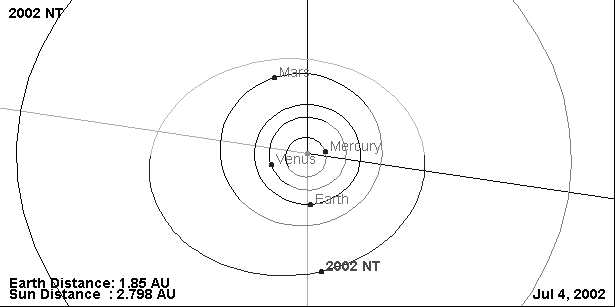 |
| Location of 2002 NT with respect to earth on discovery date, July 4th, 2002. (Credit: JPL/NASA) |